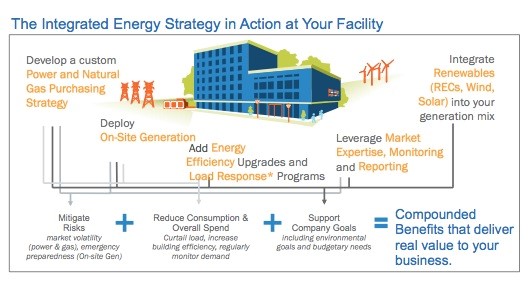How Energy Technology May Reduce Consumption and Spend: A Look at Microgrids
3 min readThe way your business receives electricity may never be the same again. In the primitive days of the electric system, before the development of a massive interconnected grid, all electricity was generated and distributed locally.
In an effort to improve grid resiliency and reduce environmental footprints, there is now movement back to the original model in many ways, using modern technologies, such as the microgrid.
The Rise of Microgrids
In 2016, the United States had about 1.6 gigawatts (GW) of installed microgrid capacity out of 1,066 GW total capacity.1 While this is a small percentage, this is expected to increase to 4.3 GW by 2020. In addition, the market value of the microgrid infrastructure is expected to reach almost $40 billion by 2027, according to Navigant Research.2
A microgrid is a source of localized power generation that can operate outside of the traditional grid and can include sources of power from renewable energy, like the sun or wind. Approximately 17 percent of total electric generation capacity came from renewable sources in 2018, according to the Energy Information Administration.3
The ability to control one’s power supply – without having to rely solely on a local utility – has become attainable for many commercial and industrial businesses.

Source: Constellation
Why Microgrids May be the Right Solution for your Business
1. They Offer Added Reliability
Power outages can be catastrophic for businesses. For hospitals, it can mean putting patients’ lives at risk. Manufacturers lose valuable production time, and food production companies that rely on cold storage can lose thousands of dollars in inventory.
Microgrids offer a backup against widespread outages, providing an alternative stream of power, even when storms or other disasters strike. Facilities can use “islandable” power, which allows for the ability to switch to their microgrid source of power if the main grid fails.
Constellation offers fuel cells, batteries, cogeneration and other assets that support distributed generation and can be used in concert with microgrids to create a holistic energy approach.
2. They Can Reduce Energy Consumption & Emissions
- Microgrids can incorporate renewable sources of power, thereby reducing carbon emissions and contributing to your business or organization’s sustainability goals.
- In addition, the use of local sources of energy to serve local loads can help reduce energy losses in transmission and distribution, further increasing efficiency of the electric delivery system, according to the U.S. Department of Energy.4
- Having the ability to monitor your energy usage puts you in control and may allow you to use less energy. Microgrids may also work well with demand-response programs, which offer financial incentives for customers who use less electricity during times of high demand.
3. They May Save you Money
- Microgrids are already paying off in areas where energy prices are high, including remote areas that have to import high-cost fuel and that lack a larger grid in which to connect. The average price of electricity in Massachusetts, for example, is almost two times the national average. A Massachusetts Institute of Technology study found that the implementation of microgrids in 22 sites in the city of Boston could generate $1.7 billion in savings over the next two decades.5
- Customers with microgrids could be eligible to generate renewable energy certificates (RECs). RECs may be retired in order to claim to “green” power, while others choose to sell them, creating yet another revenue stream.1
- Lastly, if you’re generating a surplus, you may be able to resell the energy on the market.
To read the first blog in this series on fleet electrification, click here. Stay tuned for the next blog post in this series on battery storage. Sign up for our communications at www.constellation.com/subscribe so you don’t miss it.
References
- https://www.c2es.org/site/assets/uploads/2017/06/microgrids-what-every-city-should-know.pdf
- https://microgridknowledge.com/microgrid-market-navigant/
- https://www.eia.gov/tools/faqs/faq.php?id=427&t=3
- https://www.energy.gov/oe/activities/technology-development/grid-modernization-and-smart-grid/role-microgrids-helping
- https://www.utilitydive.com/news/mit-microgrids-could-save-boston-over-1b/422325/

